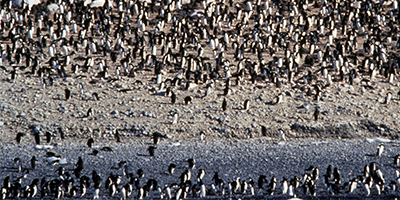Social Behavior
Penguins are among the most social of all birds. All species are colonial.
Penguins may swim and feed in groups, but some may be solitary when diving for food. Emperor penguins have been observed feeding in groups with coordinated diving.
During the breeding season penguins come ashore and nest in huge colonies called rookeries. Some rookeries include hundreds of thousands of penguins and cover hundreds of square kilometers.
Penguins exhibit intricate courting and mate-recognition behavior. Elaborate visual and vocal displays help establish and maintain nesting territories.
Although king penguins are highly gregarious at rookery sites, they usually travel in small groups of 5 to 20 individuals.
Penguins communicate by vocalizing and performing physical behaviors called "displays". They use many vocal and visual displays to communicate nesting territories and mating information. They also use displays in partner and chick recognition, and in defense against intruders.

While on land, some penguins gather in the thousands, like the Adélie penguin colony on Paulet Island off the tip of the Antarctic Peninsula.
Individual Behavior
Navigation
- Studies of Adélie penguins indicate that they use the sun to navigate from land to sea. They adjust for the sun's changing position in the sky throughout the day.
Preening
- Penguins preen their feathers frequently. Feathers must be maintained in prime condition to ensure waterproofing and insulation.
-
Penguins preen with their bills. A gland near the base of the tail secretes oil that the penguin distributes throughout its feathers.
-
Penguins preen for several minutes in the water by rubbing their bodies with their flippers while twisting and turning.
-
Penguins preen to keep their feathers in top condition and waterproof. On a well-groomed penguin, water rarely touches the skin.